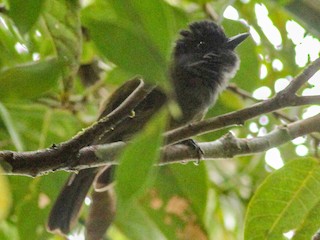Guadalcanal Hooded Whistler Pachycephala implicata Scientific name definitions
- LC Least Concern
- Names (20)
- Monotypic
Text last updated February 8, 2018
Sign in to see your badges
Species names in all available languages
| Language | Common name |
|---|---|
| Bulgarian | Гуадалканалски дебелоглав дрозд |
| Catalan | xiuladora de Guadalcanal |
| Croatian | crnoglava zviždavka |
| Dutch | Guadalcanalfluiter |
| English | Guadalcanal Hooded Whistler |
| English (United States) | Guadalcanal Hooded Whistler |
| French | Siffleur des Salomon |
| French (Canada) | Siffleur des Salomon |
| German | Olivbauch-Dickkopf |
| Japanese | ソロモンモズヒタキ |
| Norwegian | guadalcanalplystrer |
| Polish | fletówka żałobna |
| Russian | Соломонский свистун |
| Serbian | Gvadalkanalski zviždač |
| Slovak | hlaváčik kapucňový |
| Spanish | Silbador de las Salomón |
| Spanish (Spain) | Silbador de las Salomón |
| Swedish | guadalcanalvisslare |
| Turkish | Guadalkanal Islıkçısı |
| Ukrainian | Свистун меланезійський |
Pachycephala implicata Hartert, 1929
Definitions
- PACHYCEPHALA
- implicata
The Key to Scientific Names
Legend Overview
Field Identification
16·5 cm; 33·5–37 g (male) or 30–39 g (female). Male has head black, mantle to upperwing, rump and uppertail-coverts olive; tail black; chin to cheeks and upper breast dark grey, rest of underparts yellowish olive; iris dark red-brown; bill black; legs dark grey. Female has crown and sides of head grey, cheeks pale grey with slight mottling, back greenish olive, remiges black, edged olive, tail dusky, edged brown; chin grey with slight mottling, throat and upper breast pale grey, rest of underparts olive-yellow; iris dark brown. Juvenile is similar to female but crown dark olive, upperparts and underparts extensively rufous; immature as adult female.
Systematics History
Subspecies
Distribution
Mountains of Guadalcanal, in S Solomon Is.
Habitat
Forest, including mistforest at high elevations; at 1100–2000 m, at least. Co-exists with P. orioloides at some localities, but replaces that species above 1400 m.
Movement
Sedentary.
Diet and Foraging
Insects, mainly soft-bodied ones, including Orthoptera and grubs; some small snails taken, also berries and seeds. Forages mainly in understorey, occasionally to midstorey and canopy, typically alone or in pairs, and females regularly inspect mossy tree-trunks. Prey captured by gleaning along small branches.
Sounds and Vocal Behavior
Song (which is simpler, quieter and less melodious than that of P. orioloides) is a loud disyllable followed by quieter note, “wítchoo wi wítchoo, wítchoo wi woo”, with no acceleration or crescendo and given mainly at dawn; female gives single low melancholy whistle, “whew whew…”. Also harsh “chík” and “churk-chík”.
Breeding
Fledgling seen in Oct. No other information.
Conservation Status
Not globally threatened (Least Concern). Restricted-range species: present in Solomon group EBA. Reported as being generally uncommon, although locally common; generally commoner above 1400 m, where it replaces P. orioloides.

- Year-round
- Migration
- Breeding
- Non-Breeding













































